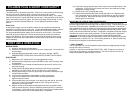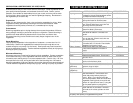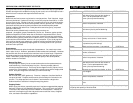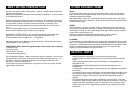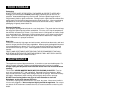
POLARIZE PLUG & SHORT CORD SAFETY..
Polarized Plug:
This appliance is for Household Use Only. Place it on a level surface, and insert plug
into any 120-volt AC electrical outlet. Do not use any other type of outlet.
This appliance has a polarized plug (one blade is wider than the other). As a safety
feature, this plug fits in a polarized outlet only one way. If the plug does not fit into the
outlet, reverse the plug and try again. Do not force the plug into the socket. If it still
does not fit, contact a qualified electrician. Do not attempt to defeat this safety
feature.
Short Cord:
A short power-supply cord is provided to reduce the risk resulting from becoming
entangled in or tripping over a longer cord. Longer detachable power-supply cords or
extension cords are available and may be used if care is exercised in their use.
If a longer detachable power-supply cord or extension cord is used, 1) the marked
electrical rating of the extension cord should be at least as great as the electrical
rating of the appliance, and 2) the longer cord should be arranged so that it will not
drape over the counter top or table where it can be pulled on by children or tripped
over accidentally.
FIRST USE & OPERATION..
BEFORE USING:
1) Carefully unpack the food dehydrator.
2) Wash the five dehydrator trays and lid in warm, soapy water. Rinse well and
dry thoroughly.
3) Wipe the dehydrator base with a clean, soft cloth or sponge. NEVER
IMMERSE BASE, CORD OR PLUG IN WATER OR ANY OTHER LIQUID.
HOW TO USE:
1) Make sure unit is switched OFF and unplugged before using.
2) Always wash the dehydrator trays and lid before each use to avoid any food
contamination.
3) Place base on a flat, smooth countertop surface where it will not fall or be
pulled by the plug.
4) Prepare food to be dehydrated as instructed in this manual; preparation
depends on the type of food. Do not overlap food or overload trays.
5) Arrange food on trays, but do not place trays on the base; stack up the trays
first and set them aside.
6) Trays may be adjusted to accommodate a variety of food sizes.
7) Plug unit into electrical wall outlet, switch to ON and preheat for
approximately 5 minutes.
8) Place stacked trays onto the base, cover the top tray with the lid, and allow
food to dry for the recommended length of time; drying time may vary
depending on the type of food.
9) Begin to check on food before the dehydration period is completed; check
food for desired dryness. Remove individual pieces and store in containers
or food bags. If some pieces are not yet done, leave them on the dehydrator
and check frequently until all food dehydration is completed.
10) Food that is not going to be eaten within a day or two should be store in the
refrigerator. If store food in the freezer, be sure to use containers or bags
designed for freezer storage.
11) Switch the unit OFF and plug after using.
12) Always wash the dehydrator trays and lid after each use. Wipe the base
with a soft damp cloth or sponge; do not allow water or any other liquid to
get into the base. Make sure the trays and lid are completely dry before
replacing them on the base.
SELECTING THE TYPE OF FOOD TO DEHYDRATE:
Food to be dried should be in good condition. Select fruits that are just ripe; they
have the highest natural form of sugar and are best for drying. Fruits that are not ripe
may have a flat, bitter taste. Vegetables should be fresh and tender. Check fruits
and vegetables for marks or bruises and cut away these portions before preparing for
dehydration. Avoid using overripe fruits and vegetables with spoiled portions. Meat,
poultry and fish should be fresh and lean. Preparation, dehydration time and storage
of foods also influence their quality and taste. Follow the preparation, dehydration
and storage instructions in this manual to ensure the best-quality dried foods.
WARNING: If you suspect food is contaminated, freeze at 0° for 48 hours to prevent
bacteria growth, or heat at 175°F for 15 minutes to pasteurize it. Some nutrition may
be lost, but it will stop the contamination process.
** ROLL-UP SHEET
The roll-up sheet is for use to dehydrate food that may have drippings that may drip
through the holes on the trays.
However, it is primarily used to make FRUIT ROLL UPS. Simply mix a mixture of
fruits until the consistency is thick and smooth. Pour the mixture over the roll-up
sheet to dehydrate for approximately 12 hours.





